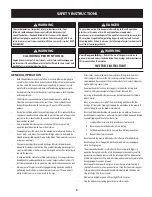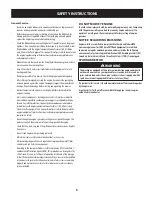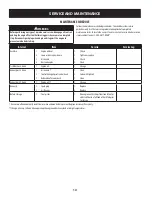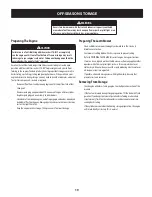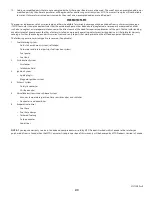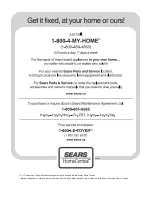
12
OPERATION
Gas & Oil
NOTE:
The engine is shipped without gasoline or oil in the engine. Running the
engine with insufficient oil can cause serious engine damage and void the engine
warranty.
WARNING
Always keep hands and feet clear of equipment moving parts. Do not use a
pressurized starting fluid. Vapors are flammable.
Oil Recommendations
Before starting engine, fill with motor oil, capacity is 600 ml/20 oz. Refer to
viscosity chart in Figure 13 for oil recommendations. Do not over-fill. Use a synthetic
or non-synthetic 4-stroke, or an equivalent high detergent, premium quality motor
oil certified to meet or exceed U.S. automobile manufacturer’s requirements for
service classification SG, SF. Motor oils classified SG, SF will show this designation
on the container.
SAE 10W-30 is recommended for general, all temperature use. If single viscosity oil
is used, select the appropriate viscosity for the average temperature in your area
from the chart below.
-30º -20º
10w
20w
20
30
40
20w40, 20w50
15w40, 15w50
10w40
10w30
-10º 0º
0º
20º 40º 60º 80º 100º
10º 20º 30º 40º
-20º
(ºC)
(ºF)
1
2
Figure 13
1.
Single Viscosity
2.
Multi Viscosity
CAUTION:
Do not use non-detergent oil or 2-stroke engine oil. It could shorten the
engine’s service life.
NOTE:
A 5w30 synthetic oil may be used to improve start ability for cold weather
(temperatures below 40
0
F).
Checking Oil Level
NOTE:
Be sure to check the oil while on a level surface with the engine stopped.
1.
Remove the oil filler cap/dipstick and wipe the dipstick clean.
2.
Insert the dipstick into the oil filler neck. Turn the dipstick a 1/4 turn into the
locked position to fully seat.
3.
Remove dipstick. If the level is low, slowly add oil to the upper limit on the
dipstick. See Figure 14 inset.
Oil Filler
Cap/Dipstick
Upper
Limit
Figure 14
4.
Reinsert the dipstick into the locked position before starting the engine.
NOTE:
Do not overfill. Overfilling with oil may cause smoking, hard starting,
spark plug fouling, or oil saturation of air cleaner.
Fuel Requirements
CAUTION
Operating the engine with E15 or E85 fuel, an oil/gasoline mixture, dirty
gasoline, or
gasoline over 30 days old
without fuel stabilizing additive
may result in damage to your engine’s carburetor. Subsequent damage
would
not
be covered under the manufacturer’s warranty.
Use automotive gasoline (unleaded or low leaded to minimize combustion chamber
deposits) with a minimum of 87 octane. Gasoline with up to 10% ethanol (E10)
or 15% MTBE (Methyl Tertiary Butyl Ether) can be used. Never use an oil/gasoline
mixture or dirty gasoline. Avoid getting dirt, dust, or water in the fuel tank.
DO
NOT use E15 or E85 gasoline.
WARNING
Gasoline is extremely flammable and is explosive under certain conditions.
Refuel in a well-ventilated area with the engine stopped. Do not smoke or allow
flames or sparks in the area where the engine is refueled or where gasoline is
stored.
•
Do not overfill the fuel tank. After refueling, make sure the tank cap is closed
properly and securely.
•
Be careful not to spill fuel when refueling. Spilled fuel or fuel vapor may
ignite. If any fuel is spilled, make sure the area is dry before starting the
engine.
•
Avoid repeated or prolonged contact with skin or breathing of vapor.



